
by Rick O'Connor | Mar 25, 2016

The majestic bald eagle. Their numbers are increasing along the Florida Panhandle.
Photo: Pensacola New Journal
ARTICLE BY DOROTHY KAUFMANN – Wildlife Sanctuary of Northwest Florida
Orphaned bald eagles are being fostered by two non-releasable adult eagles at the Wildlife Sanctuary of Northwest Florida.
The amazing story of these eagles began on St. George Island when concerned neighbors, Kevin and Chantel Burdett, Lauren Levi, and Kenny Piotrowski, rescued two fallen chicks after their nest tree came down in a storm. Emergency care began with Chris Beatty, Florida wildlife Mammal Association in Crawfordville, after being transported by Apalachicola National Estuarine Research Reserve staff. One eaglet sustained injuries from the fall while the other remained uninjured. Plans were immediately underway to rebuild a nest and return the uninjured chick. The following day both eaglets were stable enough to be transferred to the Wildlife Sanctuary in Pensacola for continued care and treatment.
A team continued working to reunite the healthy eaglet with its parents but first a replacement nest had to be built. Next, a secure tree nearby the original site had to be found for the new nest. Finally, get the nest and chick to the top of the tree. Just how many people does it take? Well, this time it was three state agencies, two wildlife rehabilitators, one veterinarian, Duke Energy – the largest electric utility in the country, with their bucket truck, one EagleWatch Program professional, several concerned citizens, and one federal agency to attempt to reunite this eaglet. “It wasn’t long before we had our ducks (eaglets) in a row for a coordinated effort to try sand reunite parents with chicks”, said Erik Lovestrand, director of the UF/IFAS Franklin County Extension Office. “Duke Energy is proud to have been part of the effort to find these baby eagles a new home”, said David Collins – government and community relations manager with Duke Energy.
The weather that had been the reason for the home nest to fall continued to dictate the little eaglet’s destiny. The reunion day turned out to be very cold and rainy for everyone. Efforts to reunite the eaglet were unsuccessful. Foster parents… yes… that’s plan B… the eaglets are both being raised by experienced “eagle parents” to have the best chance at a later release back to the wild. These adults are permanently injured bald eagles and residents of the Wildlife Sanctuary of NWFL. The injured eaglet is currently recovering at WSNF from a fractured leg and wing. Both eaglets are off display to the public due to the need to keep them wild. Video cameras at the Sanctuary allow viewing of the eagle family without any disturbance.
“Though I know we are all very disappointed that the parents did not return, we all pulled together to try to help this young eaglet which was a very awesome experience. We were so honored to be amongst such a wonderful and caring group of people”, commented Chris Beatty.
How amazing that what seemed to be a day about a single family of eagles… is actually an ongoing lesson in caring, awareness, and community.
SPECIAL NOTES:
Attending veterinarian Dr. Tommy Knight of Westside Animal Hospital
The new eagle nest site was selected by Erik Lovestrand (UF/IFAS Extension), Lauren Levi (Apalachicola NERR), and Lynda White (AEW).
Supplies for the platform were provided by Jenna Harper (Apalachicola NERR) and constructed by Kenny Piotrowski (local carpenter).
The platform was secured and eaglet placed within by Duke Energy.
Neighbor Kevin Burdett also played an important role in encouraging the adult eagles to remain in the nesting area – he played audio calls of the eaglets.
Others attending the attempted eagle reunion monitored the activity and remained in an inconspicuous location awaiting the adult eagles return.
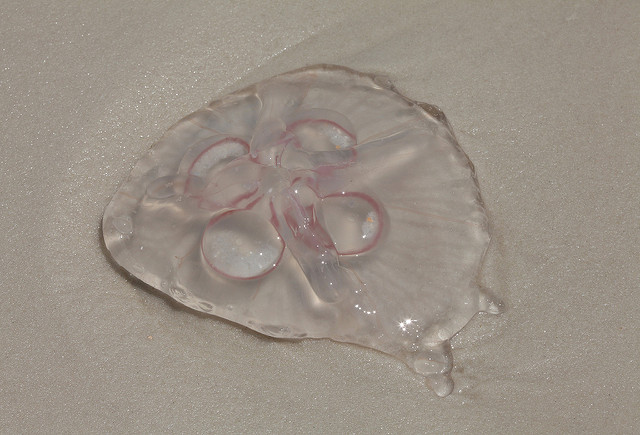
by Erik Lovestrand | Mar 25, 2016
Summertime and swimming at the beach just go together naturally in Florida with our state’s more than 1,000 miles of coastline. Many fond memories are created along these salty margins and the Panhandle region of the state has some of the top-rated beaches in the world. It is a great place to experience a relaxing, cool dip in the Gulf of Mexico on a balmy summer day. One thing to be aware of though is the possibility of an encounter with one of the Gulf’s “stinging” inhabitants and what to do if this occurs.
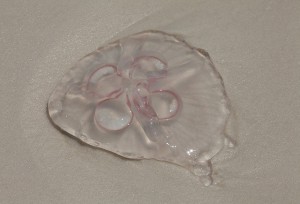
The Moon Jelly is a Common Inhabitant Along Panhandle Shores. Photo courtesy Florida Sea Grant
There are actually several different organisms that have the capability to sting. This is primarily their mechanism for capturing food but it may also serve to deter predators. Most belong to a group of organisms called “Cnidarians,” which includes the jellyfish. Most jellyfish are harmless to us and are important food sources for many other marine creatures, including some sea turtles, fish and even other jellies! Some species are even dried, shredded and eaten by humans. However, there are several types of jellyfish that will inflict a sting when brushed against and some that are actually a serious hazard. Keep in mind that people also react differently to most venoms, exhibiting varying degrees of sensitivity. The most dangerous types include some of the box jellyfish species (visit HERE for general map of worldwide jellyfish fatalities), and the blue-colored Portuguese man-o-war, which is sometimes common on our shores after sustained southerly winds during summer. A few of our locally common species that cause pain but of a generally less-severe nature include the moon jelly, sea nettle, and cannonball jellyfish. We even have some species of hydroids that look very much like a bushy brown or red algae. They are usually attached to the bottom substrate but when pieces break off and drift into the surf they can provide a painful encounter.
If you are stung there are a couple of things you can do to help and a couple of things you should not do. First, move away from the location by getting out of the water so you don’t encounter more tentacles. Carefully remove any visible tentacle pieces but not with your fingers. You should also change out of swimwear that may have trapped pieces of tentacles or tiny larval jellyfish against the skin. Do not rinse the area with fresh water as this causes the remaining stinging cells to fire their venomous harpoons. If symptoms go beyond a painful sting to having difficulty breathing or chest pain you should immediately call the Poison Information Center Network at 1-800-222-1222 or call 911.
Another thing to watch for in areas where public beaches display the beach warning flag system is a purple flag. This flag color at the beach indicates dangerous marine life and quite often it is flown when jellyfish numbers are at high levels. All of this is being written, not to scare you away from our beaches, but to help you enjoy our beautiful coastline with a little better understanding of what is out there and what to do if you happen to have a brush with a jellyfish. The vast majority of encounters are a minor irritation in an otherwise pleasant experience.
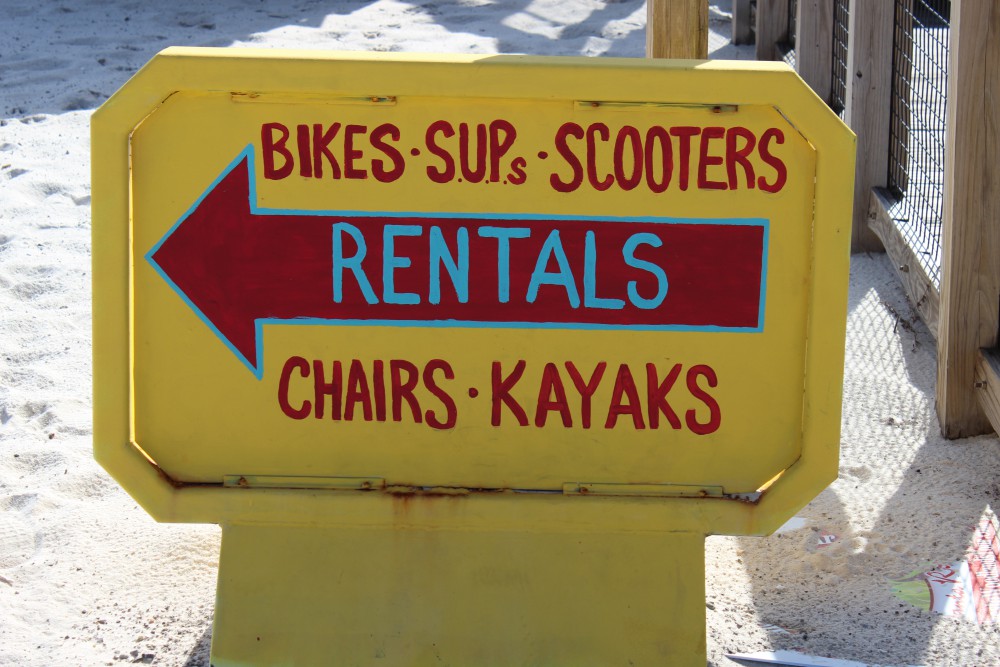
by Rick O'Connor | Mar 25, 2016
All Photos: Molly O’Connor
In this monthly series of highlighting outdoor adventures in the Florida Panhandle, we are visiting locations along the Intracoastal Waterway; from the Alabama State line to the Aucilla River. In January we wrote about Perdido Key, last month we visited Pensacola Beach, this month we move east along Santa Rosa Island to the beach community of Navarre.
Navarre Beach is a relatively quiet community on Santa Rosa Island between Pensacola and Ft. Walton Beach. There are some good places to eat, a new RV campground, and plenty of water/outdoor activities. Navarre Beach became famous in the 1970’s as the location for the film Jaws II. I personally witnessed much of the shooting of the film and it was amazing to see how it all actually all works. The hotel that was used in the film is no longer there but the stories are!
On the Island
There are some great kayak and paddle locations on Navarre Beach. Paddling over the grassbeds and to the east of the Navarre Marine Park you can see a lot of coastal wildlife and great sunsets. You can of course paddle the Gulf as well and maybe take a shot at kayak fishing. You will find local kayak rentals and guides by visiting Naturally EscaRosa website.
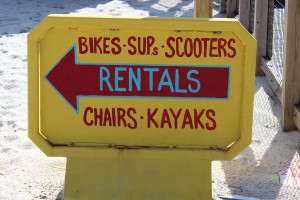
Paddling in a kayak or on a paddleboard is a great way to view wildlife and natural scenes while visiting Navarre Beach.
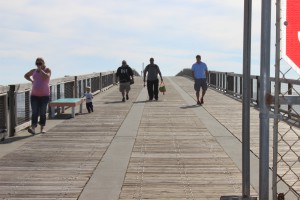
The Navarre Fishing Pier extends over 1500 feet. Not only a great place to fish but a great place to view marine life.
Speaking of fishing, there is the Navarre Beach Fishing Pier which extends 1500 feet out over the Gulf. The pier provides of variety of price options for fishermen of all ages and for $1 you can just walk and enjoy the view. Sharks and sea turtles are often seen from here – and don’t forget the sunsets.
There are two educational interpretive centers on Navarre Beach. The Navarre Beach Marine Science Station is part of the Santa Rosa County School District. They provide programs for elementary, secondary, and dual-enrolled high school-college students. The Station also provides numerous youth camps during the school year and during the summer, as well as providing activities at local community events. To see if they have something going for your young one while you are here visit their website.
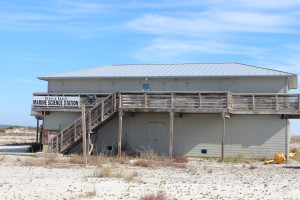
The Navarre Beach Marine Science Station provides education for young and old.
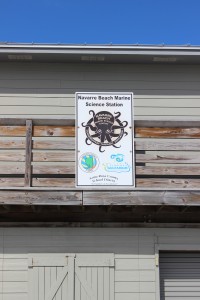
The Navarre Beach Sea Turtle Conservation Center is an educational center that focuses on imperiled marine wildlife but the sea turtle is the star of the show. The center will eventually house an injured sea turtle that can no longer be released but until one arrives, there is plenty to see and learn. Learn more about the center at their website.

The Navarre Beach Sea Turtle Conservation Center.
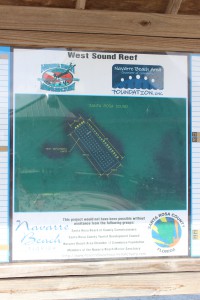
Santa Rosa County also provides a couple of nearshore snorkel reefs for the public. You can find them on both the Gulf and Sound sides.
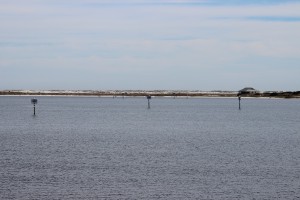
These day markers are marking two nearshore snorkel reefs on the Sound side of Navarre Beach. They can be accessed from the Navarre Marine Park.
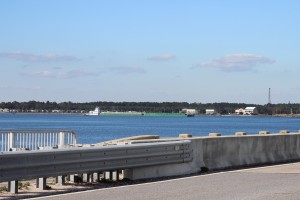
A barge travels beneath the Navarre Beach Bridge as it heads east along the ICW.
Off the island
Actually, you have to leave Santa Rosa at this point. The island between Navarre Beach and Ft. Walton Beach is the property of the United States Air Force.
As you leave Navarre Beach to travel the ICW from the north side, you see the Panhandle Butterfly House on your left at the Highway 98 traffic light. This is a great stop. Viewing live butterflies feeding on native plants in all stages of their lives is a cool sight. There are plenty of volunteers to educate you about native butterflies and there is a pond out back with a lot of turtles and birds to view. It’s a neat and relaxing place.
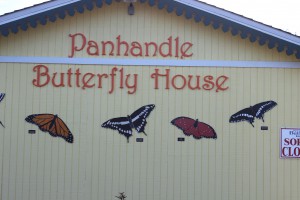
The Panhandle Butterfly House is located just to the west of the traffic light on Highway 98 as you leave Navarre Beach.

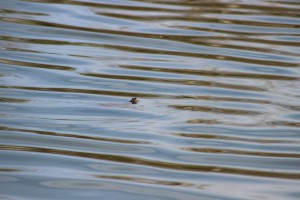
Numerous turtles can be found swimming and basking in the pond behind the butterfly house.
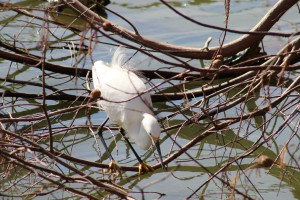
A snowy egret hunts for a meal in the turtle pond behind the butterfly house.
Nature Notes: Sea Turtles
Who doesn’t love sea turtles! These silent, charismatic creatures have been navigating Gulf waters, and nesting on our beaches for centuries. Certainly the largest species of turtle humans will encounter, weighing in between 200-300 pounds – with some reaching 1000 pounds, they are an awesome thing to see. There are five species found in the northern Gulf of Mexico and there are records of four them nesting here. Those species are the Loggerhead, Green, Kemp’s Ridley, Hawksbill, and the giant of them all the Leatherback.
Sea turtles begin their lives within the egg buried on a beach. The sex of the embryo is determined by the temperature of the sand they are incubating in – cold ones become males and 29°C appears to be the cutoff. After 60-70 days incubating the young hatchlings emerge at night and orient towards shortwave light (moon or stars off the water). However, in recent years much of the light we provide in our homes as directed them in the wrong direction (disorientation). There are “turtle friendly lights” that use longwave colors and significantly reduce the disorientation problem. All coastal counties along the panhandle require these lights for island structures. Many of the hatchlings are lost as they wonder to the Gulf. Ghost crabs, fox, coyotes, and now feral cats capture and consume many.
Those lucky enough to reach the water now have to deal with fish and bird predators. These young head offshore seeking the Sargassum mats where they will spend their growing years feeding and hiding.
As immature adults most species will return to the coastal areas to feed on seagrasses or invertebrates. As they become sexually mature they, once again, head to sea. Though they travel far and wide they are known to return to their place of birth for breeding and egg laying. Breeding takes place just offshore and females may come ashore more than once to deposit their clutch of 100+ eggs.
In addition to light pollution, marine debris, boat strikes, commercial fishing nets, and even holes and chairs left on the beach overnight have caused their numbers to decline. You should be aware that most coastal counties have a “leave no trace” ordinance asking you to remove your chairs, tents, and other items at the end of the day – and please fill in any holes you may have dug. All species of marine turtles are currently listed and protected by the U.S. Fish and Wildlife Service. In Florida, the USFWS has yield management of these species to the Florida Fish and Wildlife Conservation Commission. They are truly a magnificent creature and we hope all get to see one while exploring our beaches.
Now it is time to move to Okaloosa County – the April issue will look at Ft. Walton and Destin. Let’s head there and see what cool outdoor adventures await us.
You can find information on ecotourism providers in Escambia and Santa Rosa counties by visiting Naturally EsacRosa.
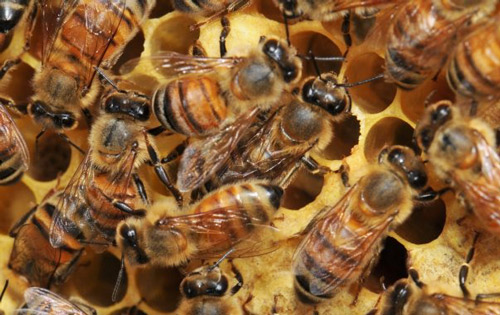
by Judy Biss | Mar 12, 2016
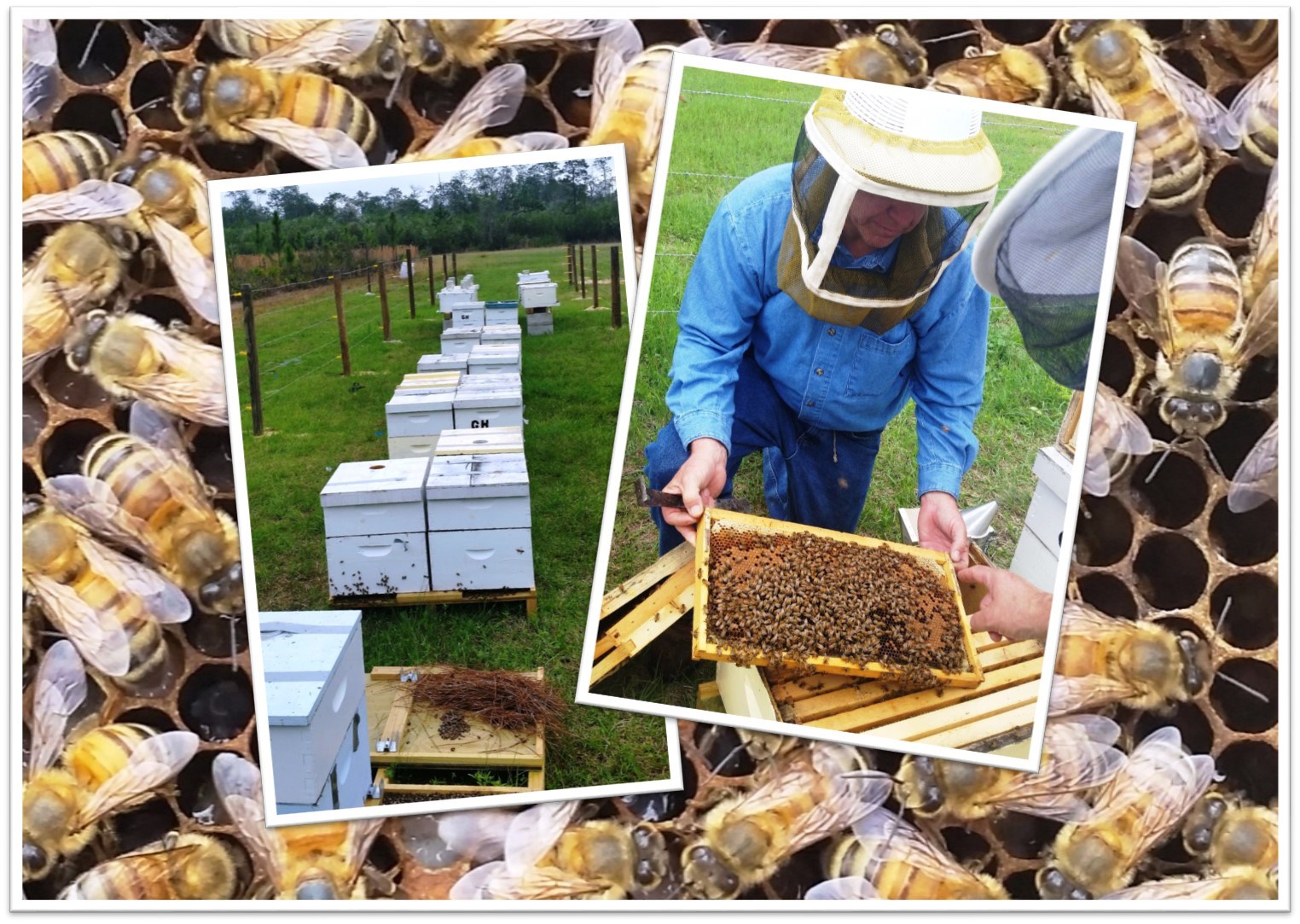 The Beekeeping in the Panhandle Working Group is pleased to offer the 5th Annual Beekeepers Field Day And Trade Show 2016 Beekeeping is one of the fastest growing hobby and commercial endeavors in Florida. There is much to learn and share about this fascinating trade.
The Beekeeping in the Panhandle Working Group is pleased to offer the 5th Annual Beekeepers Field Day And Trade Show 2016 Beekeeping is one of the fastest growing hobby and commercial endeavors in Florida. There is much to learn and share about this fascinating trade.
The workshop and trade show offers something for every level and interest, and this year’s event features:
- Extended Opportunities for Hands-On Open Hive Experiences
- Presentations on the Latest in Research-Based Beekeeping Management Practices
- Interaction With Expert Beekeepers
- Vendors with Beekeeping Equipment and Hive Products
- Door Prizes Include a Grand Prize Each Day of a 10-Frame Bee Hive!
Dates:
Friday April 1, 2016 and Saturday April 2, 2016
Place:
UF/IFAS Extension Washington County Office,
1424 Jackson Avenue, Chipley, FL 32428
850-638-6180
Time:
8:00 am – 5:00 pm each day
Registration:
Includes Lunch, Refreshments, Door Prize Tickets, & Educational Sessions
-
$25 for One Day or $40 for Both Days per Person
-
$10 Age 12 and Under Each Day
-
Late Fee of $10.00 after March 22nd.
Two ways to register:
For More Information Contact:
- UF/IFAS Extension Washington County at 850-638-6180
- UF/IFAS Extension Calhoun County at 850-674-8323
Download the printable flyer with agenda & details:
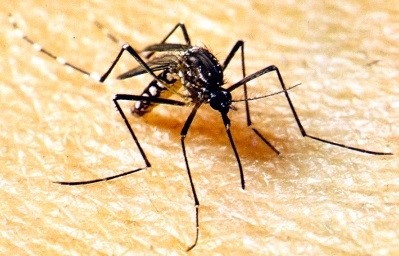
by Sheila Dunning | Mar 12, 2016
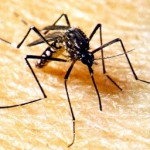 With all the news about the Zika virus spread in Florida, now is the time to start thinking about mosquito protection. As the weather warms, they will be hatching. Check out where the water is collecting in your yard. The female Aedes aegypti mosquitoes lay their eggs in temporary flood water pools; even very small ones such as pet watering bowls, bird baths and upturned Magnolia or Oak leaves. Dumping out the collection containers and raking through the leaves every couple of days can greatly reduce the population.
With all the news about the Zika virus spread in Florida, now is the time to start thinking about mosquito protection. As the weather warms, they will be hatching. Check out where the water is collecting in your yard. The female Aedes aegypti mosquitoes lay their eggs in temporary flood water pools; even very small ones such as pet watering bowls, bird baths and upturned Magnolia or Oak leaves. Dumping out the collection containers and raking through the leaves every couple of days can greatly reduce the population.
Becoming infected with Zika virus is not common. Though the disease can be transmitted by mosquitoes, blood transfusions or sex, the only know infections in Florida were from people who had been “bitten” by mosquitoes while travelling to countries with active virus outbreaks. That is until this past week, when a person-person infection occurred between a man that had been infected while out of the country and the woman he returned to in Florida. Mosquitoes usually obtain the virus by feeding on infected people, who may not exhibit any symptoms because they have been exposed and their body has built an immunity to the virus. Once the mosquito has drawn infected blood from the person, the infected mosquito “bites” another human, transmitting the virus mixed in saliva into the blood stream of the second host. If the second host is a susceptible pregnant woman, there is a risk of birth defects for the unborn child. If the infected host is a man, he can transmit the virus in semen for about two weeks.
Government public health officials here in Florida are able to monitor mosquito-borne illnesses quickly and effectively. Though the daily news can be alarming, the awareness is truly the message.
To protect yourself and reduce the sources for mosquitoes to breed, here are a few pointers:
Stay indoors at dusk (peak mosquito biting time).
If you must be outside, wear long sleeves and pants and/or mosquito repellents containing the active ingredient DEET.
Repair torn door and window screens.
Remove unnecessary outside water sources.
Flush out water collected in outdoor containers every 3-4 days.
Disturb or remove leaf litter, including roof gutters and covers on outdoor equipment.
Apply larvicides, such as Bacillus thuriengensis israelensis (BTI) to temporary water holding areas and containers.
The mosquitoes have been around all winter with the milder weather and frequent rain. As spring approaches they will be laying eggs on all the water surfaces they can find. As you venture out into the yard or travel to the great outdoors, remember to protect yourself and look at all the ways you can remove the potential habitats for the pesky creatures.





















